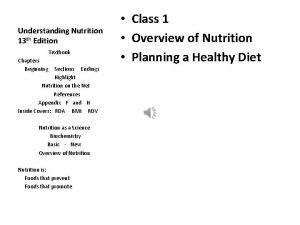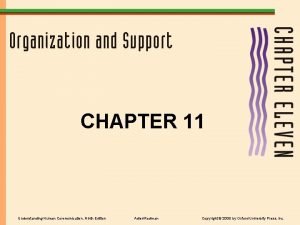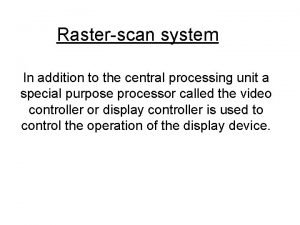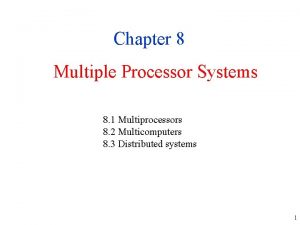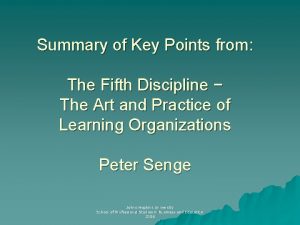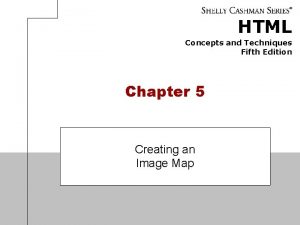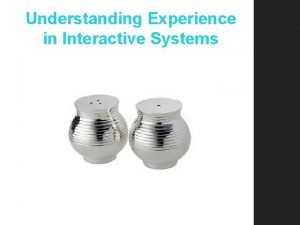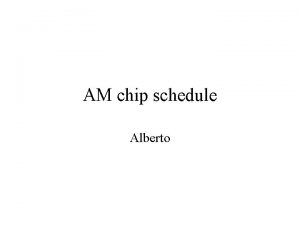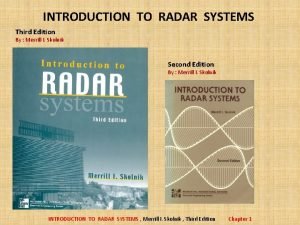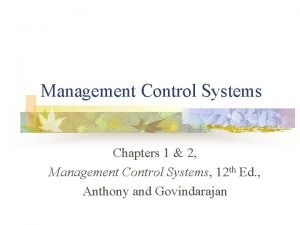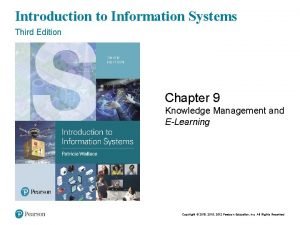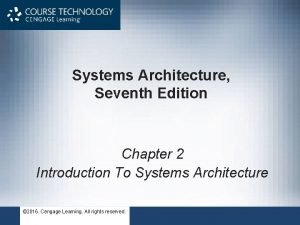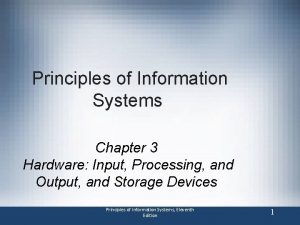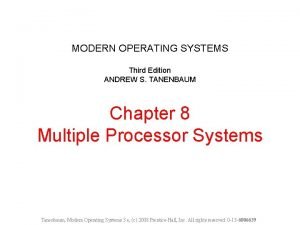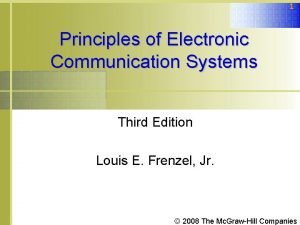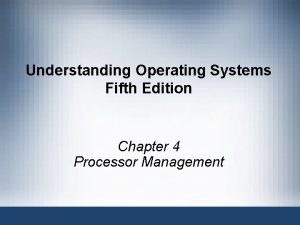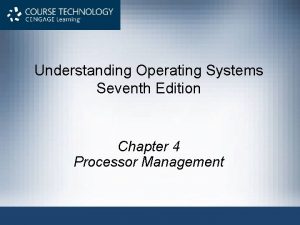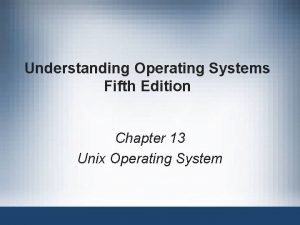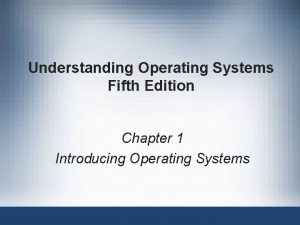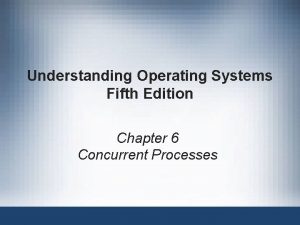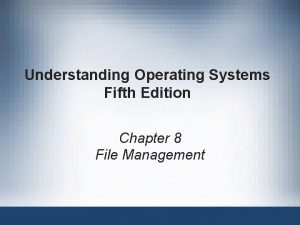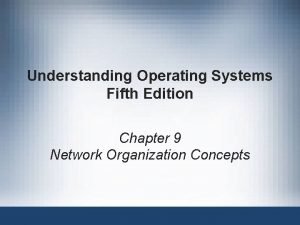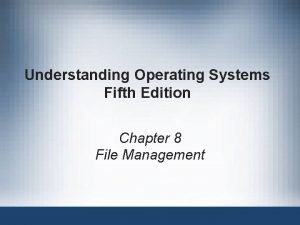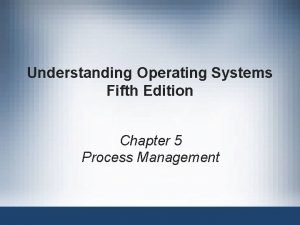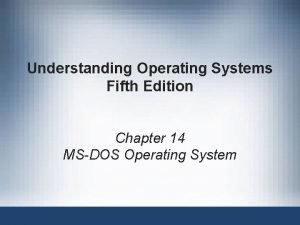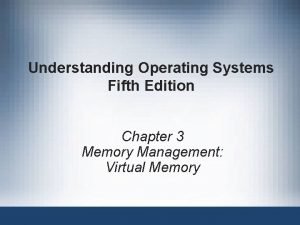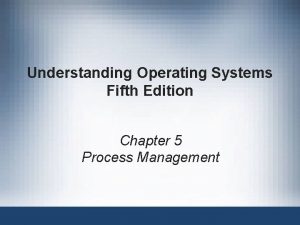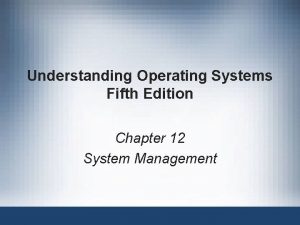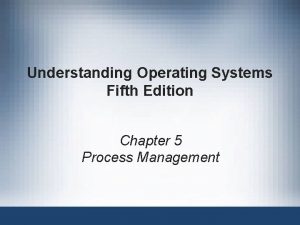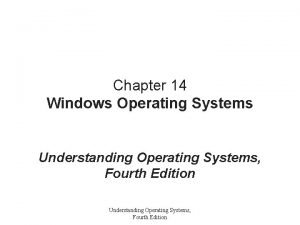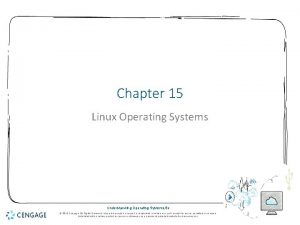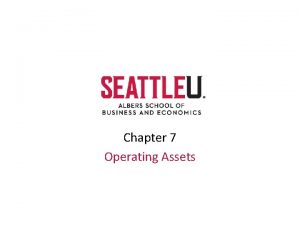Understanding Operating Systems Fifth Edition Chapter 4 Processor


















































- Slides: 50

Understanding Operating Systems Fifth Edition Chapter 4 Processor Management

Overview • Single-user systems (two states) – Busy state: executing a job – Idle state: all other times – Simple processor management • Program (job) – Inactive unit • File stored on a disk – A unit of work submitted by a user • Not a process Understanding Operating Systems, Fifth Edition 2

Overview (continued) • Process (task) – Active entity • Requires resources to perform function • Processor and special registers – Executable program single instance • Thread – Portion of a process – Runs independently • Processor – Central processing unit (CPU) – Performs calculations and executes programs Understanding Operating Systems, Fifth Edition 3

Overview (continued) • Multiprogramming environment – Processor allocated for a time period – Deallocated at appropriate moment: delicate task • Interrupt – Call for help – Activates higher-priority program • Context Switch – Saving job processing information when interrupted • Single processor – May be shared by several jobs (processes) – Requires scheduling policy and scheduling algorithm Understanding Operating Systems, Fifth Edition 4

Job Scheduling Versus Process Scheduling • Processor Manager – Composite of two submanagers • Hierarchy between them • Job Scheduler: higher-level scheduler – Job scheduling responsibilities – Job initiation based on certain criteria • Process Scheduler: lower-level scheduler – Process scheduling responsibilities – Determines execution steps – Process scheduling based on certain criteria Understanding Operating Systems, Fifth Edition 5

Job Scheduling Versus Process Scheduling (continued) • Job Scheduler functions – Selects incoming job from queue – Places in process queue – Decides on job initiation criteria • Process scheduling algorithm and priority • Goal – Sequence jobs • Efficient system resource utilization – Balance I/O interaction and computation – Keep most system components busy most of time Understanding Operating Systems, Fifth Edition 6

Process Scheduler • Chapter focus • Process Scheduler functions – Determines job to get CPU resource • When and how long – Decides interrupt processing – Determines queues for job movement during execution – Recognizes job conclusion • Determines job termination • Lower-level scheduler in the hierarchy Understanding Operating Systems, Fifth Edition 7

Process Scheduler (continued) • Exploits common computer program traits – Programs alternate between two cycles • CPU and I/O cycles • Frequency and CPU cycle duration vary • General tendencies exists – I/O-bound job • Many brief CPU cycles and long I/O cycles (printing documents) – CPU-bound job • Many long CPU cycles and shorter I/O cycles (math calculation) Understanding Operating Systems, Fifth Edition 8

Process Scheduler (continued) • Poisson distribution curve – CPU cycles from I/O-bound and CPU-bound jobs Understanding Operating Systems, Fifth Edition 9

Job and Process Status • Jobs move through the system • Five states – – – HOLD READY WAITING RUNNING FINISHED • Called job status or process status Understanding Operating Systems, Fifth Edition 10

Job and Process Status (continued) Understanding Operating Systems, Fifth Edition 11

Job and Process Status (continued) • User submits job (batch/interactive) – Job accepted • Put on HOLD and placed in queue – Job state changes from HOLD to READY • Indicates job waiting for CPU – Job state changes from READY to RUNNING • When selected for CPU and processing – Job state changes from RUNNING to WAITING • Requires unavailable resources – Job state changes to FINISHED • Job completed (successfully or unsuccessfully) Understanding Operating Systems, Fifth Edition 12

Job and Process Status (continued) • Job Scheduler (JS) or Process Scheduler (PS) incurs state transition responsibility – HOLD to READY • JS initiates using predefined policy – READY to RUNNING • PS initiates using predefined algorithm – RUNNING back to READY • PS initiates according to predefined time limit or other criterion – RUNNING to WAITING • PS initiates by instruction in job Understanding Operating Systems, Fifth Edition 13

Job and Process Status (continued) • Job Scheduler (JS) or Process Scheduler (PS) incurs state transition responsibility (continued) – WAITING to READY • PS initiates by signal from I/O device manager • Signal indicates I/O request satisfied; job continues – RUNNING to FINISHED • PS or JS initiates upon job completion • Satisfactorily or with error Understanding Operating Systems, Fifth Edition 14

Process Control Blocks • Data structure • Contains basic job information – – – What it is Where it is going How much processing completed Where stored How much time spent using resources Understanding Operating Systems, Fifth Edition 15

Process Control Blocks (continued) • Process Control Block (PCB) components – Process identification • Unique – Process status • Job state (HOLD, READY, RUNNING, WAITING) – Process state • Process status word, register contents, main memory info, resources, process priority – Accounting • Billing and performance measurements • CPU time, total time, memory occupancy, I/O operations, number of input records read, etc. Understanding Operating Systems, Fifth Edition 16

Process Control Blocks (continued) Understanding Operating Systems, Fifth Edition 17

PCBs and Queuing • Job PCB – – Created when Job Scheduler accepts job Updated as job executes Queues use PCBs to track jobs Contains all necessary job management processing data – PCBs linked to form queues (jobs not linked) – Manage queues using process scheduling policies and algorithms Understanding Operating Systems, Fifth Edition 18

PCBs and Queuing (continued) Understanding Operating Systems, Fifth Edition 19

Process Scheduling Policies • Multiprogramming environment – More jobs than resources at any given time • Operating system pre-scheduling task – Resolve three system limitations • Finite number of resources (disk drives, printers, tape drives) • Some resources cannot be shared once allocated (printers) • Some resources require operator intervention (tape drives) Understanding Operating Systems, Fifth Edition 20

Process Scheduling Policies (continued) • Good process scheduling policy criteria – Maximize throughput • Run as many jobs as possible in given amount of time – Minimize response time • Quickly turn around interactive requests – Minimize turnaround time • Move entire job in and out of system quickly – Minimize waiting time • Move job out of READY queue quickly Understanding Operating Systems, Fifth Edition 21

Process Scheduling Policies (continued) • Good process scheduling policy criteria (continued) – Maximize CPU efficiency • Keep CPU busy 100 percent of time – Ensure fairness for all jobs • Give every job equal CPU and I/O time • Final policy criteria decision in designer’s hands Understanding Operating Systems, Fifth Edition 22

Process Scheduling Policies (continued) • Problem – Job claims CPU for very long time before I/O request issued • Builds up READY queue and empties I/O queues • Creates unacceptable system imbalance • Solution – Interrupt • Used by Process Scheduler upon predetermined expiration of time slice • Current job activity suspended • Reschedules job into READY queue Understanding Operating Systems, Fifth Edition 23

Process Scheduling Policies (continued) • Types of scheduling policies – Preemptive • Used in time-sharing environments • Interrupts job processing • Transfers CPU to another job – Nonpreemptive • Functions without external interrupts – Infinite loops interrupted in both cases Understanding Operating Systems, Fifth Edition 24

Process Scheduling Algorithms • Base on specific policy – Allocate CPU and move job through system • Six algorithm types – – – First-come, first-served (FCFS) Shortest job next (SJN) Priority scheduling Shortest remaining time (SRT) Round robin Multiple-level queues • Current systems emphasize interactive use and response time (use preemptive policies) Understanding Operating Systems, Fifth Edition 25

First-Come, First-Served • Nonpreemptive • Job handled based on arrival time – Earlier job arrives, earlier served • Simple algorithm implementation – Uses first-in, first-out (FIFO) queue • Good for batch systems • Unacceptable in interactive systems – Unpredictable turnaround time • Disadvantages – Average turnaround time varies; seldom minimized Understanding Operating Systems, Fifth Edition 26

First-Come, First-Served (continued) Understanding Operating Systems, Fifth Edition 27

Shortest Job Next • • Non pre-emptive Also known as shortest job first (SJF) Job handled based on length of CPU cycle time Easy implementation in batch environment – CPU time requirement known in advance • Does not work well in interactive systems • Optimal algorithm – All jobs are available at same time – CPU estimates available and accurate Understanding Operating Systems, Fifth Edition 28

Shortest Job Next (continued) Understanding Operating Systems, Fifth Edition 29

Priority Scheduling • Non pre-emptive • Preferential treatment for important jobs – Highest priority programs processed first – No interrupts until CPU cycles completed or natural wait occurs • READY queue may contain two or more jobs with equal priority – Uses FCFS policy within priority • System administrator or Processor Manager use different methods of assigning priorities Understanding Operating Systems, Fifth Edition 30

Priority Scheduling (continued) • Processor Manager priority assignment methods – Memory requirements • Jobs requiring large amounts of memory allocated lower priorities (or vice versa) – Number and type of peripheral devices • Jobs requiring many peripheral devices allocated lower priorities (or vice versa) Understanding Operating Systems, Fifth Edition 31

Priority Scheduling (continued) • Processor Manager priority assignment methods (continued) – Total CPU time • Jobs having a long CPU cycle given lower priorities (or vice versa) – Amount of time already spent in the system (aging) • Total time elapsed since job accepted for processing • Increase priority if job in system unusually long time Understanding Operating Systems, Fifth Edition 32

Shortest Remaining Time (SRT) • Pre-emptive version of SJN • CPU allocated to job closest to completion – Pre-emptive if newer job has shorter completion time • Often used in batch environments – Short jobs given priority • Cannot implement in interactive system – Requires advance CPU time knowledge • Involves more overhead than SJN – System monitors CPU time for READY queue jobs – Performs context switching at pre-emption time. Understanding Operating Systems, Fifth Edition 33

Shortest Remaining Time (continued) Understanding Operating Systems, Fifth Edition 34

Round Robin • Pre-emptive • Used extensively in interactive systems • Based on predetermined slice of time – Each job assigned time quantum • Time quantum size – Crucial to system performance – Varies from 100 ms to 1 -2 seconds • CPU equally shared among all active processes – Not monopolized by one job Understanding Operating Systems, Fifth Edition 35

Round Robin (continued) • Job placed on READY queue (FCFS scheme) • Process Scheduler selects first job – Sets timer to time quantum – Allocates CPU • Timer expires • If job CPU cycle > time quantum – Job preempted and placed at end of READY queue – Information saved in PCB Understanding Operating Systems, Fifth Edition 36

Round Robin (continued) • If job CPU cycle < time quantum – Job finished: allocated resources released and job returned to user – Interrupted by I/O request: information saved in PCB and linked to I/O queue • Once I/O request satisfied – Job returns to end of READY queue and awaits CPU Understanding Operating Systems, Fifth Edition 37

Round Robin (continued) Understanding Operating Systems, Fifth Edition 38

Round Robin (continued) • Efficiency – Depends on time quantum size • In relation to average CPU cycle • Quantum too large (larger than most CPU cycles) – Algorithm reduces to FCFS scheme • Quantum too small – Context switching occurs • Job execution slows down • Overhead dramatically increased Understanding Operating Systems, Fifth Edition 39

Round Robin (continued) Understanding Operating Systems, Fifth Edition 40

Round Robin (continued) • Best quantum time size – Depends on system • Interactive: response time key factor • Batch: turnaround time key factor – General rules of thumb • Long enough for 80% of CPU cycles to complete • At least 100 times longer than context switch time requirement Understanding Operating Systems, Fifth Edition 41

Multiple-Level Queues • Works in conjunction with several other schemes • Works well in systems with jobs grouped by common characteristic – Priority-based • Different queues for each priority level – CPU-bound jobs in one queue and I/O-bound jobs in another queue – Hybrid environment • Batch jobs in background queue • Interactive jobs in foreground queue • Scheduling policy based on predetermined scheme • Four primary methods Understanding Operating Systems, Fifth Edition 42

Case 1: No Movement Between Queues • Simple • Rewards high-priority jobs – CPU allocated to jobs in high-priority queues using FCFS • CPU allocated to lower-priority jobs – Only when high-priority queues empty • Good environment if: – There are few high-priority jobs so the high-priority queue empties quickly allowing the CPU to spend more time with low-priority jobs Understanding Operating Systems, Fifth Edition 43

Case 2: Movement Between Queues • CPU adjusts priorities assigned to each job • High-priority jobs – Initial priority is favorable but • treated like all other jobs afterwards • Quantum interrupt – Job is preempted and • Moved to next lower queue • May have priority increased (e. g. when a job issues an I/O request before its time quantum has expired). • Good environment: – When jobs handled by cycle characteristics (CPU or I/O) – Facilitates I/O bound jobs and so a good environment for interactive systems Understanding Operating Systems, Fifth Edition 44

Case 3: Variable Time Quantum Per Queue • Case 2 variation: movement between queues • Each queue given time quantum size – Size twice as long as previous queue • Fast turnaround for CPU-bound jobs • CPU-bound jobs execute longer and given longer time periods – Improves chance of finishing faster Understanding Operating Systems, Fifth Edition 45

Case 4: Aging • Ensures lower-level queue jobs eventually complete execution • System keeps track of job wait time • If too “old” – System moves job to next highest queue – Continues until old job reaches top queue – May drastically move old job to highest queue • Advantage – Guards against indefinite unwieldy job postponement (i. e. starvation). Understanding Operating Systems, Fifth Edition 46

A Word About Interrupts • Interrupt Types – Page interrupt (memory manager) • Accommodate job requests – Time quantum expiration interrupt – I/O interrupt • Result when a READ or WRITE command is issued – Internal interrupt (synchronous interrupt) • Result from arithmetic operation or job instruction – Illegal arithmetic operation interrupt • Dividing by zero; bad floating-point operation generating an overflow or underflow Understanding Operating Systems, Fifth Edition 47

A Word About Interrupts (continued) • Interrupt Types (continued) – Illegal job instruction interrupt • Protected or non-existent storage access attempt • Attempts to make system changes, such as trying to change the size of the time quantum. • Interrupt handler – Control program • Handles interruption event sequence Understanding Operating Systems, Fifth Edition 48

A Word About Interrupts (continued) • When a non-recoverable error is detected by the operating system – Interrupt handler sequence is as follows: • Interrupt type described and stored (to be passed on as an error message to the user) • Interrupted process state saved (including value of the program counter and contents of all registers) • Interrupt is processed (job processing is terminated if nonrecoverable interrupt occurs, resources allocated to the job are released an error message is sent to the user; for an I/O interrupt (recoverable), the job is moved to the I/O queue; for a time quantum interrupt (recoverable), the job is moved to the READY queue). • Processor resumes normal operation Understanding Operating Systems, Fifth Edition 49

Summary Understanding Operating Systems, Fifth Edition 50
 Types of operating system
Types of operating system Modern operating systems 3rd edition
Modern operating systems 3rd edition Tanenbaum structured computer organization
Tanenbaum structured computer organization Principles of marketing fifth european edition
Principles of marketing fifth european edition Facial feedback hypothesis
Facial feedback hypothesis Fundamentals of corporate finance fifth edition
Fundamentals of corporate finance fifth edition Fifth edition chemistry a molecular approach
Fifth edition chemistry a molecular approach Mitosis
Mitosis Molecular biology of the cell fifth edition
Molecular biology of the cell fifth edition Human anatomy fifth edition
Human anatomy fifth edition Human anatomy fifth edition
Human anatomy fifth edition Understanding human communication 14th edition chapter 1
Understanding human communication 14th edition chapter 1 Business essentials 12th edition answer key
Business essentials 12th edition answer key Understanding nutrition 13th edition rental
Understanding nutrition 13th edition rental Copyright
Copyright Understanding human differences 5th edition
Understanding human differences 5th edition Understanding earth 7th edition
Understanding earth 7th edition Understanding earth 7th edition
Understanding earth 7th edition Understanding earth 5th edition
Understanding earth 5th edition Adler and rodman 2006
Adler and rodman 2006 Type of rock
Type of rock Linear vs relational worldview
Linear vs relational worldview Display processor unit
Display processor unit Multiple processor systems
Multiple processor systems Using mis 10th edition
Using mis 10th edition Chapter 1
Chapter 1 Operating system
Operating system Operating system concepts 6th edition
Operating system concepts 6th edition The fifth discipline summary
The fifth discipline summary Fifth chapter menu
Fifth chapter menu Understanding experience in interactive systems
Understanding experience in interactive systems Transalate
Transalate Principles of electronic communication systems 3rd edition
Principles of electronic communication systems 3rd edition Modern systems analysis and design
Modern systems analysis and design Introduction to radar systems skolnik
Introduction to radar systems skolnik Introduction to information systems 6th edition
Introduction to information systems 6th edition Fundamentals of information systems 9th edition
Fundamentals of information systems 9th edition Fundamentals of information systems 9th edition
Fundamentals of information systems 9th edition White-collar workers คือ
White-collar workers คือ Vertical
Vertical What is goal congruence in management control system
What is goal congruence in management control system Introduction to information systems 3rd edition
Introduction to information systems 3rd edition Introduction to information systems 5th edition
Introduction to information systems 5th edition Systems architecture 7th edition pdf
Systems architecture 7th edition pdf Principles of information systems
Principles of information systems Principles of information systems 11th edition
Principles of information systems 11th edition Modern systems analysis and design 7th edition
Modern systems analysis and design 7th edition Distributed systems third edition
Distributed systems third edition Fundamentals of information systems
Fundamentals of information systems Essentials of mis, 13th edition
Essentials of mis, 13th edition Principles of electronic communication systems 3rd edition
Principles of electronic communication systems 3rd edition













